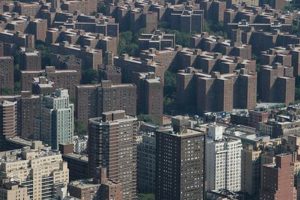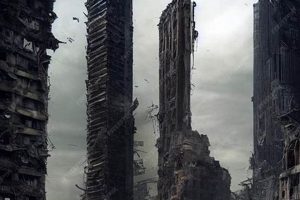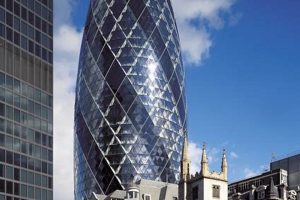The term “smallest skyscraper” can refer to a building that holds the record for being the shortest skyscraper in the world or to a general category of skyscrapers that are relatively short in height compared to other skyscrapers. The Council on Tall Buildings and Urban Habitat (CTBUH) defines a skyscraper as a building that is at least 150 meters (492 feet) tall, but there is no official definition of what constitutes the “smallest skyscraper.”
There are a number of reasons why a building might be considered the smallest skyscraper. One reason is that it may be the first skyscraper to be built in a particular city or region. Another reason is that it may be a particularly iconic or architecturally significant building. For example, the Home Insurance Building in Chicago, which was built in 1885, is often considered to be the first skyscraper in the world. It is only 10 stories tall, but it is a landmark building that helped to define the Chicago skyline.
There are also a number of benefits to building smaller skyscrapers. Smaller skyscrapers are less expensive to build and maintain than taller skyscrapers. They also have a smaller environmental impact, as they require less energy to heat and cool. Additionally, smaller skyscrapers can be more easily integrated into the surrounding cityscape, as they do not cast as large a shadow or block as much sunlight.
1. Height
The height of a skyscraper is one of its most defining characteristics. Small skyscrapers are typically shorter than 150 meters (492 feet), but there is no official definition of what constitutes the “smallest skyscraper.” This is because the definition of a skyscraper can vary depending on the organization or individual defining it. For example, the Council on Tall Buildings and Urban Habitat (CTBUH) defines a skyscraper as a building that is at least 150 meters (492 feet) tall, while the Emporis Standards Committee defines a skyscraper as a building that is at least 100 meters (328 feet) tall.
- Shorter Height: Small skyscrapers are shorter than traditional skyscrapers, typically falling below 150 meters (492 feet) in height. This reduced height allows for more efficient construction and maintenance, making them more cost-effective options.
- Urban Integration: The smaller size of these buildings enables them to blend seamlessly into the surrounding urban environment. They can fit into tight spaces and complement existing structures, contributing to a cohesive cityscape.
- Sustainable Design: Small skyscrapers often incorporate sustainable design elements due to their reduced height and scale. They can utilize natural light, incorporate green spaces, and employ energy-efficient systems, resulting in environmentally friendly buildings.
- Architectural Creativity: Despite their smaller size, small skyscrapers present unique architectural challenges and opportunities. Architects can explore innovative designs, experiment with different materials, and create visually striking structures that redefine the traditional skyscraper aesthetic.
In conclusion, the height of a small skyscraper is a crucial factor that sets it apart from taller skyscrapers. It influences construction costs, urban integration, sustainable design, and architectural creativity. Small skyscrapers offer a range of benefits and design possibilities, making them valuable additions to the urban landscape.
2. Location
The location of small skyscrapers is closely linked to their definition and characteristics. Dense urban areas, where land is scarce and building heights are restricted, provide the ideal setting for small skyscrapers to thrive. Several factors contribute to this connection:
- Land scarcity: In densely populated cities, land is a valuable commodity, making it expensive to acquire large plots for high-rise developments. Small skyscrapers offer a viable solution by maximizing vertical space utilization while occupying a smaller footprint.
- Building height restrictions: Many urban areas have building height restrictions in place to preserve historical landmarks, maintain neighborhood character, or mitigate air traffic concerns. Small skyscrapers comply with these restrictions while still providing substantial floor area and maximizing views.
- Urban fabric integration: Small skyscrapers can be seamlessly integrated into existing urban fabric without overpowering their surroundings. Their reduced height allows them to blend in with neighboring buildings, respecting the scale and character of the cityscape.
Real-life examples of small skyscrapers in dense urban areas include:
- 40 Wall Street, New York City: Standing at 92 meters (302 feet), 40 Wall Street is one of the smallest skyscrapers in Manhattan. It was built in 1930 and is known for its Art Deco design and proximity to the New York Stock Exchange.
- The Mark, London: Located in the exclusive Mayfair neighborhood, The Mark is a 13-story skyscraper that rises to 53 meters (174 feet). Completed in 2014, it is renowned for its luxurious apartments and innovative design.
- One Central Park, Sydney: At 117 meters (384 feet), One Central Park is the tallest residential building in Australia. Its unique design incorporates lush rooftop gardens, creating a green oasis in the heart of Sydney’s Central Business District.
Understanding the connection between location and small skyscrapers is crucial for urban planning and sustainable development. By maximizing vertical space utilization and complying with building height restrictions, small skyscrapers contribute to the efficient use of land and the preservation of urban character. They also promote walkability, reduce energy consumption, and enhance the overall livability of dense urban environments.
3. Purpose
The purpose of a building is a fundamental aspect that influences its design, functionality, and overall appeal. Small skyscrapers, with their unique height and scale, offer a range of possibilities for diverse uses. This adaptability is a defining characteristic of small skyscrapers and contributes to their relevance in urban environments.
Real-life examples showcase the versatility of small skyscrapers across different purposes:
- Office Space: Small skyscrapers provide efficient and modern office environments. They offer ample floor space for businesses, maximizing vertical space utilization in dense urban areas. An example is the 280 Park Avenue building in New York City, a 20-story skyscraper primarily used for office space.
- Residential Units: Small skyscrapers cater to the growing demand for urban living. They offer luxurious and convenient residential units with stunning views and amenities. The 40-story Sapphire Tower in Chicago is an example of a small skyscraper designed for residential purposes.
- Retail Space: Small skyscrapers can incorporate retail space on their lower floors, creating a vibrant street-level experience. They attract shoppers and contribute to the commercial activity of the surrounding area. One example is the 12-story Nordstrom Tower in Seattle, which houses a flagship Nordstrom department store.
Understanding the diverse purposes of small skyscrapers is crucial for urban planning and development. It allows architects and urban planners to design buildings that meet the specific needs of a community. Small skyscrapers can accommodate various functions, revitalize urban areas, and enhance the overall livability of cities.
4. Design
The design of small skyscrapers is closely tied to their unique characteristics and purpose. To overcome height limitations and optimize space utilization, architects often employ innovative design solutions that maximize natural light and create the illusion of spaciousness.
- Vertical Emphasis: Small skyscrapers often emphasize verticality to create a sense of grandeur and draw the eye upward. This can be achieved through the use of slender profiles, soaring facades, and rhythmic vertical elements.
- Facade Design: The facade of a small skyscraper plays a crucial role in maximizing natural light and reducing the sense of enclosure. Architects use large windows, transparent materials, and reflective surfaces to bring in ample daylight and create open, airy interiors.
- Atrium and Skylights: Atriums and skylights are common features in small skyscrapers. They allow natural light to penetrate deep into the building, reducing the need for artificial lighting and creating a more inviting and spacious atmosphere.
- Multi-Functional Spaces: Small skyscrapers often incorporate multi-functional spaces to optimize space utilization. These spaces can serve multiple purposes, such as a lobby that doubles as an event space or a rooftop terrace that offers panoramic views.
The innovative design solutions employed in small skyscrapers not only enhance their aesthetic appeal but also contribute to a more sustainable and comfortable built environment. By maximizing natural light and creating a sense of spaciousness, these buildings promote well-being and reduce energy consumption.
5. Sustainability
The sustainability of small skyscrapers is a significant advantage that contributes to their overall appeal. Their reduced height and scale offer inherent benefits in terms of energy efficiency and environmental impact, making them attractive options for eco-conscious developments and urban planning.
- Energy Efficiency: Smaller buildings require less energy to heat and cool compared to larger skyscrapers. This is because they have a smaller surface area exposed to the external environment, reducing heat loss and gain. Additionally, small skyscrapers can incorporate passive design strategies such as natural ventilation and daylighting to further reduce energy consumption.
- Reduced Carbon Footprint: The reduced energy consumption of small skyscrapers translates into a lower carbon footprint. By using less energy, these buildings contribute to mitigating greenhouse gas emissions and promoting sustainable urban environments.
- Sustainable Materials: Small skyscrapers often utilize sustainable building materials and construction methods to minimize their environmental impact. These materials can include recycled materials, low-VOC (volatile organic compound) paints, and energy-efficient appliances.
- Green Certifications: Many small skyscrapers are designed to achieve green building certifications, such as LEED (Leadership in Energy and Environmental Design) or BREEAM (Building Research Establishment Environmental Assessment Method). These certifications verify the sustainability performance of buildings and provide recognition for their environmental initiatives.
The sustainability of small skyscrapers is a key factor in their growing popularity. By reducing energy consumption, minimizing their carbon footprint, and promoting sustainable practices, small skyscrapers contribute to creating greener and more sustainable cities.
6. Cost
The cost-effectiveness of small skyscrapers is a significant factor contributing to their appeal. The reduced height and scale of these buildings result in lower construction and maintenance costs compared to larger skyscrapers. This cost advantage offers several benefits and practical implications.
Firstly, the lower construction costs make small skyscrapers more accessible to developers and investors. This accessibility encourages the development of diverse and innovative building projects, contributing to a more vibrant and varied urban landscape. Moreover, the reduced maintenance costs over the building’s lifespan translate into lower operational expenses for building owners and tenants, making small skyscrapers an attractive long-term investment.
Real-life examples showcase the cost-effectiveness of small skyscrapers. The 11-story New York by Gehry building in New York City is a notable example. Designed by renowned architect Frank Gehry, the building features a unique and striking design while maintaining a modest height. The cost-effectiveness of the project allowed for the creation of affordable luxury apartments, making it a successful and sought-after residential building.
Understanding the connection between cost and the definition of “smallest skyscraper” is crucial for urban planning and development. By considering cost-effectiveness, architects and developers can create sustainable and livable urban environments that meet the needs of diverse communities and budgets. The cost advantage of small skyscrapers makes them a viable option for expanding housing stock, promoting urban renewal, and revitalizing neighborhoods.
7. Historical significance
The historical significance of small skyscrapers lies in their pioneering role in the development of urban skylines and architectural innovation. These early skyscrapers, despite their modest height compared to modern standards, played a crucial role in shaping the identity of cities and showcasing architectural advancements.
- Architectural Pioneering: Small skyscrapers were often the first examples of high-rise buildings in their respective cities or regions, pushing the boundaries of architectural design and construction techniques. They showcased innovative structural systems, facade treatments, and building materials, setting the stage for future skyscraper developments.
- Urban Landmar
ks: As pioneers in their field, small skyscrapers often became iconic landmarks, symbolizing the progress and ambition of their cities. They served as focal points for urban development and attracted attention from both locals and visitors, contributing to the city’s cultural heritage. - Historical Context: Small skyscrapers provide valuable insights into the architectural and social history of a city. They reflect the prevailing design styles, technological capabilities, and economic conditions of their time, offering a tangible connection to the past.
- Preservation and Recognition: Many historically significant small skyscrapers are recognized for their architectural and cultural value and are protected through preservation efforts. They serve as reminders of the city’s architectural evolution and contribute to the preservation of its unique character.
In conclusion, the historical significance of small skyscrapers stems from their role as architectural pioneers, urban landmarks, and valuable historical artifacts. Recognizing and preserving these early skyscrapers not only celebrates the city’s architectural heritage but also provides a tangible connection to the past while inspiring future architectural endeavors.
8. Architectural significance
The architectural significance of small skyscrapers lies in their unique contributions to the field of architecture. These buildings, despite their modest height, often showcase innovative design elements and bear the signatures of renowned architects, making them valuable additions to the urban landscape. Understanding the connection between architectural significance and the definition of “smallest skyscraper” offers valuable insights into the evolution of architectural styles and the importance of design excellence in shaping urban environments.
Small skyscrapers designed by renowned architects, such as Frank Gehry’s IAC Building in New York City, often become landmarks and cultural icons. These buildings push the boundaries of architectural design, experimenting with unconventional forms, materials, and structural systems. They serve as testaments to the creativity and vision of their architects, attracting attention from both the public and architectural enthusiasts.
Moreover, small skyscrapers can incorporate innovative design elements that enhance their functionality, sustainability, and aesthetic appeal. For instance, the Bosco Verticale in Milan, designed by Stefano Boeri Architetti, features lush vertical gardens integrated into its facade. This innovative design not only adds a unique aesthetic element but also improves air quality and reduces the building’s carbon footprint.
Recognizing the architectural significance of small skyscrapers is crucial for several reasons. Firstly, it highlights the importance of design excellence in creating visually appealing and functional urban environments. Secondly, it encourages architects to explore innovative design solutions even within height constraints. Finally, it helps preserve architecturally significant buildings, ensuring their legacy and contribution to the city’s architectural heritage.
In conclusion, the architectural significance of small skyscrapers stems from their innovative design elements and association with renowned architects. Understanding this connection allows us to appreciate the value of design excellence and its impact on the urban landscape. Preserving and celebrating architecturally significant small skyscrapers not only ensures their longevity but also serves as an inspiration for future architectural endeavors.
9. Cultural significance
The cultural significance of small skyscrapers lies in their ability to embody and reflect the collective memory and identity of a community. These buildings, while modest in height compared to their larger counterparts, often hold a special place in the hearts of locals and visitors alike due to their association with significant events or influential figures.
- Historical Events: Small skyscrapers can become cultural landmarks by serving as backdrops for or being directly involved in historical events. The Empire State Building in New York City, for example, gained cultural significance as the site of King Kong’s fateful climb in the 1933 film.
- Commemorative Structures: Small skyscrapers can be built specifically to commemorate important events or individuals. The One World Trade Center in New York City, completed in 2014, stands as a powerful symbol of resilience and remembrance following the tragic events of 9/11.
- Architectural Icons: Some small skyscrapers achieve cultural significance due to their unique and iconic designs. The Flatiron Building in New York City, known for its triangular shape, has become a beloved symbol of the city’s architectural heritage.
- Association with Personalities: Small skyscrapers can also become cultural landmarks through their association with famous people. The Dakota Apartments in New York City gained notoriety as the residence of John Lennon, and its facade became a site of mourning and pilgrimage following his assassination.
Understanding the cultural significance of small skyscrapers is crucial for several reasons. Firstly, it highlights the importance of preserving these buildings as they embody the collective memory and identity of a community. Secondly, it encourages architects and developers to consider the cultural impact of their designs and to create buildings that resonate with the community. Finally, it promotes a deeper appreciation for the diverse architectural heritage that small skyscrapers contribute to our cities.
FAQs about “Smallest Skyscraper”
This section addresses frequently asked questions related to the term “smallest skyscraper.”
Question 1: What exactly defines a “smallest skyscraper”?
The definition of a “smallest skyscraper” is not universally agreed upon, but it generally refers to a building that is shorter than the typical definition of a skyscraper, which is 150 meters (492 feet) tall. However, there is no official cutoff point, and some sources use different criteria, such as 100 meters (328 feet) tall.
Question 2: Why are small skyscrapers becoming increasingly popular?
Small skyscrapers offer several advantages over larger skyscrapers. They are less expensive to build and maintain, have a smaller environmental impact, and can be more easily integrated into the surrounding cityscape.
Question 3: What are some examples of small skyscrapers?
There are many examples of small skyscrapers around the world, including the Flatiron Building in New York City, the Rialto Building in Chicago, and the One Central Park building in Sydney, Australia.
Question 4: What are the benefits of building small skyscrapers?
Small skyscrapers offer a number of benefits, including lower construction and maintenance costs, reduced environmental impact, and increased integration with the surrounding cityscape.
Question 5: What are the challenges of building small skyscrapers?
Small skyscrapers can present a number of challenges, including the need to maximize space and light, the need to comply with building codes,
and the need to design buildings that are visually appealing.
Question 6: What is the future of small skyscrapers?
Small skyscrapers are likely to continue to grow in popularity as cities become more dense and land becomes more scarce. They offer a number of advantages over larger skyscrapers, and they can be designed to meet the specific needs of a community.
In conclusion, small skyscrapers offer a number of advantages over larger skyscrapers, and they are likely to continue to grow in popularity in the future.
Tips on Incorporating Small Skyscrapers into Urban Environments
Small skyscrapers can offer a number of benefits to urban environments, including increased density, reduced environmental impact, and enhanced livability. However, there are also a number of challenges to consider when designing and constructing small skyscrapers.
Tip 1: Consider the context.
When designing a small skyscraper, it is important to consider the surrounding context. The building should be compatible with the scale and character of the neighborhood, and it should not overshadow or dwarf neighboring buildings.
Tip 2: Maximize natural light.
Small skyscrapers can often feel dark and cramped, so it is important to maximize natural light. This can be done by using large windows, skylights, and atriums.
Tip 3: Create a sense of community.
Small skyscrapers can often feel isolated and impersonal, so it is important to create a sense of community. This can be done by providing shared amenities, such as rooftop gardens, fitness centers, and community rooms.
Tip 4: Use sustainable design principles.
Small skyscrapers can be designed to be sustainable and environmentally friendly. This can be done by using energy-efficient materials and systems, and by incorporating green features, such as rooftop gardens and solar panels.
Tip 5: Be creative.
Small skyscrapers can be designed in a variety of ways. There is no one-size-fits-all approach. Be creative and explore different design options to find the best solution for the specific site and context.
By following these tips, architects and developers can create small skyscrapers that are both aesthetically pleasing and functional. Small skyscrapers can play a valuable role in creating more dense, sustainable, and livable urban environments.
Conclusion
The term “smallest skyscraper” refers to a building that is shorter than the typical definition of a skyscraper, which is 150 meters (492 feet) tall. However, there is no official cutoff point, and some sources use different criteria, such as 100 meters (328 feet) tall.
Small skyscrapers offer a number of advantages over larger skyscrapers, including lower construction and maintenance costs, reduced environmental impact, and increased integration with the surrounding cityscape. As cities become more dense and land becomes more scarce, small skyscrapers are likely to continue to grow in popularity.
When designing and constructing small skyscrapers, it is important to consider the following factors:
- The context of the building
- The need to maximize natural light
- The importance of creating a sense of community
- The use of sustainable design principles
- The need to be creative
By following these tips, architects and developers can create small skyscrapers that are both aesthetically pleasing and functional. Small skyscrapers can play a valuable role in creating more dense, sustainable, and livable urban environments.







